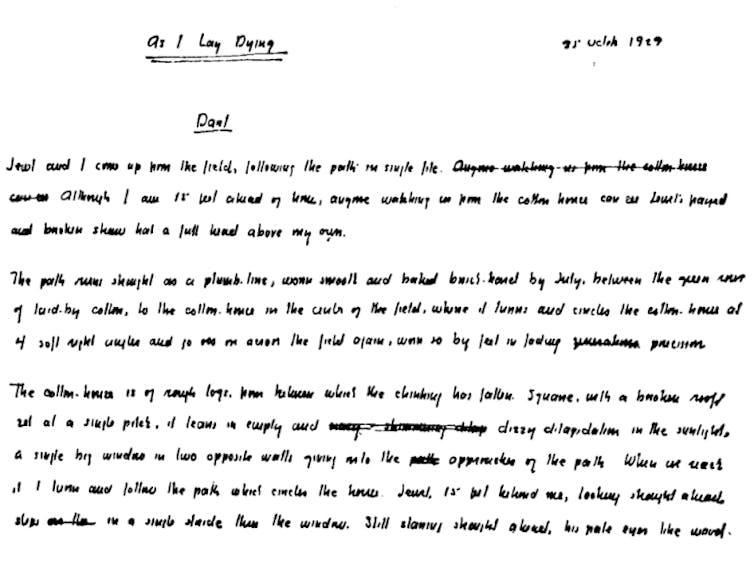After hearing that our class was going to attempt a reading of Faulkner’s classic As I Lay Dying, I hadn’t the faintest idea what to expect. I knew nothing of the novel’s premise, and several friends of mine who had tackled the text in high school warned me to tread carefully, not because the text […]

Vardaman Logic
Vardaman is the youngest of the Bundren crew, and he takes his mothers death the hardest. He does not know where to place the blame. The book never mentions his age, but it is estimated that he is probably around twelve years old based on the way he talks. He is young and does not […]
Faulkner and the Southern Renaissance
The Southern Renaissance was a movement within Southern American literature in the 20s and 30s. William Faulkner is widely regarded as one of the most important writers to come out of this time. He was awarded a Nobel Prize for Literature in 1949. The Southern Renaissance, and her authors, were responding to the notion that […]

Representing The Mentality of the Great Depression in As I Lay Dying
Faulkner’s As I Lay Dying, published in 1930, is markedly one of the first novels to introduce stream of consciousness narration to the public. Faulkner wrote the entirety of the novel over the course of six weeks, from midnight until 4am, during his break at the power plant where he was working. It is interesting […]
Between Two Allegiances
During the conclusion to Nella Larsen’s “Passing,” there is a huge focus given to the fact that Irene chooses to ‘protect’ Clare’s continuing “disguise” in regards to her husband. Of course, this ends with the penultimate scene where Mr. Bellew confronts the dinner party that his wife is attending, and Irene pushes Clare to her […]
Passing and Wakanda
When looking at Passing, there’s an interesting discussion to be found on whether or not the novel holds a certain legacy or impact in present time. Published in 1929, the novel arrived in a time plagued with racial turmoil. Since then equality and racism has progressed significantly, yet one of the themes within the novel […]

One-Drop Rule
The subject of Part I in Passing is Clare Kendry’s ability to “pass” for white, and essentially fool her abhorrently racist husband into thinking she is white. During Jack’s rant about the apparent darkening of Clare’s skin, she asks him, “My goodness, Jack! What difference would it make if, after all these years, you were to find […]

“Poor as Church Mice”
I was shocked when I read the part about Clare’s aunts, and how they would use bible versus to justify how they treated Clare. Clare describes them as “good Christians”, and justifies their actions by saying that they made her who she is today. Christians in the past would also use bible versus to justify […]
Passing in Real Life: Nella Larsen as the muse to her own characters
Nella Larsen’s “Passing” is named so in reference to the concept that one may “pass” as a race that is not their own. From the first part of the novel, we understand that several of the women introduced are either passing all the time (such as with Clare), or have the ability to (such as […]
Passing as Disguise: The Usage of the N-Word by John Bellow
Nella Larsen’s Passing gets its title from the practice of passing, which is defined by an article from Time as “identifying with and presenting oneself as one race while denying ancestry of another.” In the novel, Clare Kendry has “passed” by disguising her African American heritage, which is successful due to her light skin color. […]